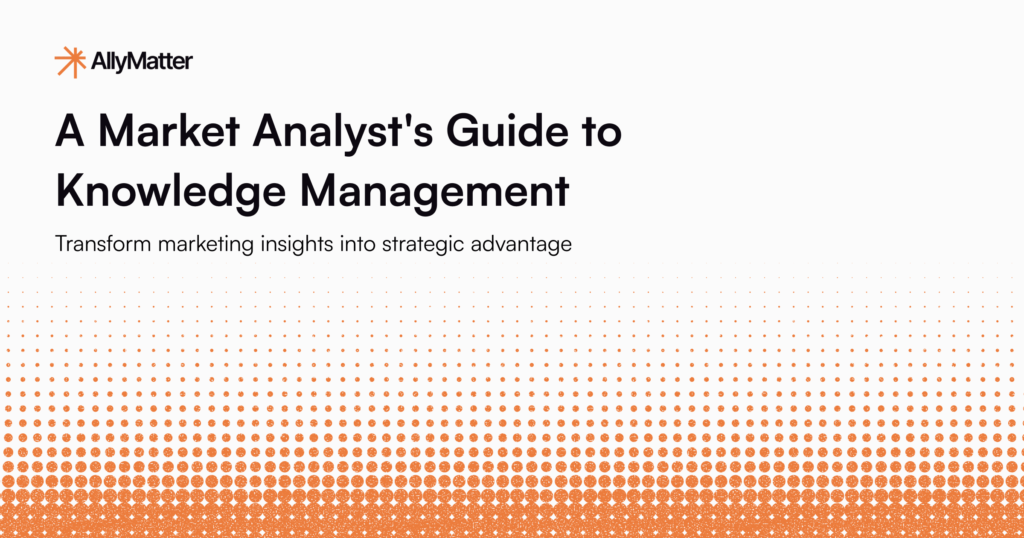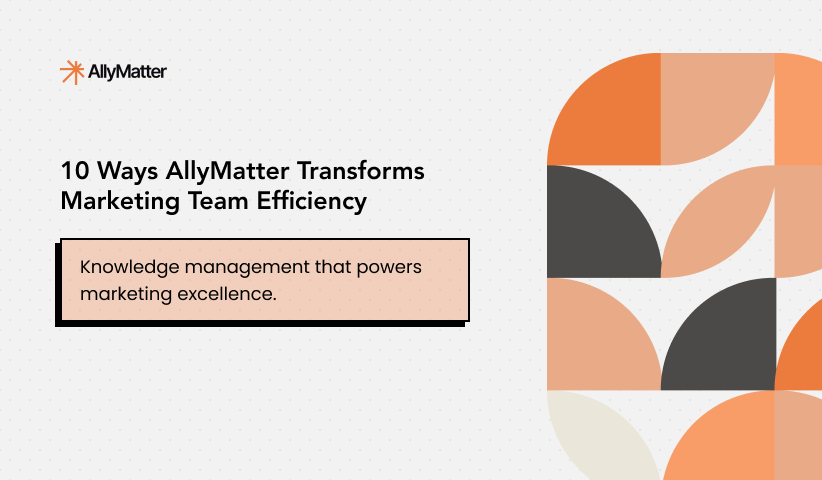Your marketing team just lost a key member who took years of process knowledge with them. New campaigns now take twice as long to launch because no one can find the right templates or remember the approval steps. Meanwhile, your documented processes from last year already feel outdated as channels and tactics have evolved.
A living marketing playbook solves these problems by creating a dynamic knowledge base for marketing that captures institutional wisdom while continuously evolving. Unlike static documentation that quickly grows stale, a living playbook becomes more valuable over time, capturing lessons learned and refining processes with each campaign.
For companies looking to scale, this approach transforms marketing from personality-dependent efforts into scalable, repeatable processes that improve with each iteration. Let’s explore how to build a marketing knowledge base that gets smarter every quarter.
Why traditional marketing playbooks gather dust
“We documented all our processes two years ago, but no one uses them anymore.”
This common frustration stems from fundamental flaws in how marketing teams approach marketing documentation:
Static documentation can’t keep pace with change. Modern marketing moves at the speed of digital platforms – algorithms change, channels emerge and decline, and best practices evolve constantly. When your playbook exists as a static snapshot in time, it becomes a historical artifact rather than an operational tool.
Marketing teams end up maintaining parallel systems: official documentation for compliance and onboarding, and unofficial “real” processes that actually guide their work. This disconnect undermines the very purpose of documentation and creates unnecessary cognitive load on your team.
Knowledge silos create inefficiencies. Every week, employees spend a lot of time waiting for information from colleagues or recreating existing knowledge. When marketing insights live only in team members’ heads or scattered across tools, collaboration suffers.
Undocumented processes create unnecessary risks. When key team members leave, they take valuable knowledge with them. The Panopto Workplace Knowledge and Productivity Report shows that U.S. knowledge workers spend 5.3 hours each week unproductively, either waiting on colleagues for information or rebuilding existing knowledge.
Your marketing documentation system needs an upgrade if your team frequently asks:
- “Didn’t we already solve this problem before?”
- “Who knows how we did that successful campaign last year?”
- “Where are the latest versions of our templates?”
- “What’s our process for this channel again?”
Evaluate your current marketing documentation if:
- Team members repeatedly ask the same process questions
- Campaign setup takes longer with different team members
- New hires struggle to find current templates and guidelines
Essential components of an effective marketing playbook
A comprehensive marketing playbook should centralize all critical knowledge while remaining accessible and useful. Here’s what to include:

Core campaign frameworks and templates: Document your campaign planning process, including audience research methods, messaging frameworks, and campaign brief templates. This creates consistency across initiatives while allowing flexibility for different channels and goals.
Channel-specific processes and guidelines: Each marketing channel requires specific expertise. Document best practices, posting schedules, format requirements, and performance benchmarks for each channel your team uses.
Brand assets and guidelines: Centralize your visual identity elements, messaging guidelines, and voice documentation to ensure consistent brand representation across all touchpoints.
Performance measurement methodologies: Document how your team tracks and reports on marketing performance, including which metrics matter for different initiatives and how to gather and interpret data from various platforms.
Team roles and responsibilities: Clarify who owns which processes and decisions, creating accountability while preventing bottlenecks from unclear ownership.
Vendor and partner management: Document relationships with agencies, freelancers, and marketing technology vendors, including contacts, services, and process workflows for engagement.
Creating a system for continuous improvement
A living marketing playbook becomes more valuable over time through intentional learning cycles. Here’s how to implement this approach:
Implement quarterly review sessions: Schedule dedicated time each quarter for your marketing team to review documentation, discuss what’s changed, and update accordingly. This transforms documentation from an administrative burden to a strategic tool.
Create post-campaign knowledge capture: After each significant campaign, document:
- What worked well and should be replicated
- What didn’t work and should be avoided
- Unexpected challenges and how they were addressed
- Resources that should be created for next time

Megan, a marketing manager at a growing SaaS company, implemented this approach after losing her content strategist mid-campaign. When the replacement started, instead of spending weeks recreating campaign frameworks, they found documented processes, approved templates, and lessons learned from previous initiatives. This reduced their onboarding time from three weeks to five days.
Establish clear version control: Without proper version tracking, teams waste time hunting for the most current documentation. Implement a system that clearly shows:
- When each document was last updated
- Who made the changes
- What specifically changed
- Why the update was needed
Build knowledge contribution into workflows: Make documentation part of the campaign process, not a separate activity. When updating your playbook becomes part of campaign wrap-up, it happens naturally rather than becoming postponed indefinitely.
Technology enablers for living documentation
The right technology can transform knowledge management from a burden to an advantage. Look for these essential capabilities:
Collaborative editing with accountability: Your solution should allow multiple team members to contribute while maintaining oversight of who changed what and when.
Robust search and organization: Marketing teams create vast amounts of documentation. Without excellent search capabilities and intuitive organization, finding information becomes prohibitively time-consuming.
Version control and audit trails: When someone makes changes, the system should track what changed, who made the changes, and when they occurred. This creates accountability and helps trace the evolution of your processes.
Granular access controls: Not everyone needs access to everything. Your system should allow role-based permissions to ensure team members can find what they need while maintaining appropriate marketing knowledge governance.
Integration capabilities: Your marketing playbook should connect with your broader marketing technology ecosystem to reduce friction and increase adoption.
Implementation best practices
Start with your most critical processes: Begin by documenting your highest-value, most frequently used processes. This creates immediate value while building momentum for broader documentation efforts.
Create templates that reduce workload: Well-designed templates don’t create extra work, they eliminate it. Design your documentation to make the right way the easiest way.
Train teams on both content and system: Ensure team members understand not just how to find information but also how to contribute to the knowledge base. The more collaborative your approach, the more valuable your marketing team’s knowledge sharing becomes.
Measure documentation effectiveness: Track metrics like:
- Time saved in onboarding new team members
- Reduction in repeated questions
- Consistency in campaign execution
- Team satisfaction with knowledge accessibility
How AllyMatter transforms marketing knowledge management
AllyMatter addresses the unique challenges marketing teams face when managing campaign documentation, brand assets, and process knowledge. The platform enables marketing teams to build an internal knowledge base that grows smarter with each campaign through features designed for collaborative documentation:
- Smart approval flows ensure your playbook remains accurate without creating bottlenecks.
- Granular access control lets you manage what internal and external stakeholders can view and edit.
- Complete audit trails track every change for accountability.
- Version control shows exactly how your processes have evolved.
- Intelligent organization with custom tags makes finding marketing assets and processes intuitive.
Marketing teams using AllyMatter can centralize campaign documentation, standardize processes across channels, and preserve institutional knowledge even as teams change.
Key takeaways
- Traditional static playbooks quickly become outdated in fast-moving marketing environments.
- A living marketing playbook captures knowledge while continuously improving processes.
- Effective marketing documentation requires both the right information architecture and regular maintenance cycles.
- Technology can substantially reduce the friction of keeping documentation current.
- Begin with documenting your most frequently used campaign processes to demonstrate immediate value.
Ready to build a marketing knowledge base that evolves with your team? Join our waitlist to be among the first to experience AllyMatter’s collaborative documentation platform.
Frequently asked questions
How often should we update our marketing playbook?
Your marketing playbook should follow a hybrid update schedule. Core processes should undergo quarterly reviews aligned with your planning cycles, while campaign-specific learnings should be captured immediately after campaign completion. The most successful teams create a continuous feedback loop where insights flow directly into documentation rather than treating updates as a separate administrative task. For rapidly evolving channels like social media, consider monthly light reviews to incorporate platform changes and emerging best practices.
Who should be responsible for maintaining our marketing knowledge base?
Rather than assigning maintenance to a single person (creating a bottleneck and single point of failure), implement a distributed ownership model where different team members own specific sections aligned with their expertise. A marketing operations manager or content strategist should oversee the overall structure and maintenance schedule, but individual subject matter experts should be responsible for keeping their sections current. This approach ensures documentation reflects true expertise while preventing maintenance from falling to the bottom of everyone’s priority list.
What’s the difference between a marketing playbook and a standard marketing plan?
A marketing plan outlines specific goals, strategies, tactics, and timelines for a defined period (typically a year). A marketing playbook, by contrast, documents the “how” behind executing any marketing initiative, your processes, best practices, templates, and institutional knowledge. While a marketing plan is time-bound and outcome-focused, a playbook is evergreen and process-focused. The most effective marketing teams maintain both: plans that outline what they’ll achieve and playbooks that standardize how they’ll achieve it.
How can we measure the ROI of a well-maintained marketing knowledge base?
Measure both efficiency gains and quality improvements. For efficiency, track metrics like onboarding time for new team members, time spent searching for information, and campaign setup speed. For quality, compare performance consistency across similar campaigns and monitor error rates in deliverables. Many organizations find that properly documented processes reduce onboarding time while increasing campaign performance consistency. The highest ROI typically comes from documenting frequent, high-value processes that previously relied heavily on tribal knowledge, making them vulnerable to staff transitions and inconsistent execution.


